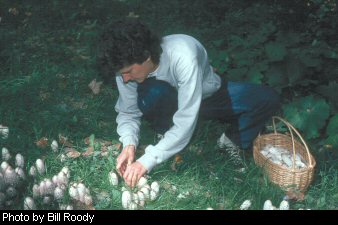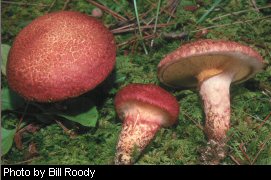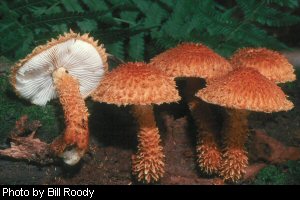

Gathering of Fall MushroomsBy Bill Roody
For those who prize edible mushrooms, the Shaggy Mane ( Coprinus comatus ) is one to look for in grassy places and on disturbed ground where they often fruit in large numbers. These distinctive, scaly mushrooms, which resemble a drum majorette's hat, are also known as Ink Caps and Lawyer's Wigs . Unlike other mushrooms that have radiating gills on the underside of the cap, the Shaggy Mane does not open up fully like an umbrella as it matures. Instead, the cap remains more or less cylindrical or bullet-shaped. The reproductive spores that are formed on the gill faces are released from the lower edge of the cap. As the spores are dispersed the gill tissue dissolves into a black inky fluid. This liquid was actually used for ink before more reliable inks were developed. The “meltdown” of the cap takes place progressively from the base of the cap moving upward, until all that remains of older specimens is a tall stalk with a ragged, dripping disc at the top. The 18th century English poet Percy Shelley surely had the Shaggy Mane in mind when he penned the lines: And their mass rotted off them flake by flake, Till the thick stalk stuck like a murderer's stake, Where rags of loose flesh yet tremble on high, Infecting the winds that wander by. Despite Shelley's rather morbid tone, this is a pretty good description of the mushroom as it matures. Before the gills begin to liquefy, the Shaggy Mane with its scaly white cap is quite beautiful. It is also good to eat, but only when young before the meltdown process begins. Since these are highly perishable mushrooms, they should be cooked or refrigerated soon after collecting. They are especially delicious when briefly parboiled, then marinated in seasoned vinegar and oil, and served cold. Many mushrooms only grow in association with certain types of trees. The relationship between trees and the mushrooms that frequently grow beneath them is called “ mycorrhiza .” It is beneficial to both organisms. Hidden in the soil is a complex network of microscopic strands of fungus called “mycelium.” This is the vegetative stage of a fungus, which periodically produces mushrooms. In a mycorrhizal relationship the mycelium is connected to the roots of trees. Through photosynthesis, the tree manufactures simple sugars, which it supplies to the fungus. In return the attached fungus mycelium spreads through the soil for distances well-beyond reach of the normal root system and acts like a sponge, absorbing and transferring nutrients and moisture to the tree. Everybody wins! The Slippery Jack ( Suillus luteus )is a bolete that forms mycorrhiza with pine trees. As with other boletes it has a sponge-like layer of tubes beneath the cap rather than gills. Many different boletes live in West Virginia but the Slippery Jack is distinctive by having a purple-tinged membranous collar on the stalk and a sticky The Painted Bolete ( Suillus pictus ) can be found from July to November but only beneath White Pine, with which it forms a host-specific mycorrhiza . Although the Painted Bolete is edible and easy to recognize, always confirm the identification and edibility of any wild mushroom that you intend to eat using a guidebook that includes detailed descriptions. Some mushrooms are dangerously poisonous if eaten . The Deadly Galerina ( Galerina autumnalis ) is a small, brown, wood-decaying mushroom that has caused fatal poisonings. It grows on wood mulch, decaying In late summer and early fall the fortunate mushroom hunter may encounter Hen of the Woods ( Grifola frondosa ), so called because of its fanciful resemblance to a sitting hen. This large, compound mushroom occurs as a weak parasite on the roots of oak trees, and since it doesn't kill the host tree, you can return year after year to the same location to harvest additional fruitings . This tasty mushroom, which is also known as Sheep's Head , is typically the size of a basketball, or sometimes much larger. The waxy caps in the genus Hygrophorus are well represented late in the season. These mushrooms are not so interesting from a culinary point of view but many are brightly colored and attractive. Some have brilliant red, yellow, or orange caps, while others in the group have more subdued, earthy colors. The name “waxy cap” comes from an overall waxy appearance and because the gills have a waxy feel (a bit like candlewax ) when crushed between the fingers. The Scarlet Waxy Cap ( Hygrophorus coccineus ) is a small but striking mushroom with a blood-red to orange-red cap and stalk, and orangish gills. It grows on the ground in woods, in moss, or on well-decayed woody debris. West Virginia's forests are particularly rich in wild mushrooms. Many are essential decomposers of wood and forest litter. Others form beneficial mycorrhizal partnerships with trees. Mushrooms are also important food items for wildlife and some are quite delicious for people too. If the rains come this fall, there will be plenty of wild mushrooms to enjoy for their beauty, interesting biology, and as unique food. Look for them on your next woodland walk. Once you are “tuned in” to mushrooms, you will be amazed at the variety and abundance in our state. Bill Roody is a seasonal biologist and author of Mushrooms of West Virginia and the Central Appalachians, published by Kentucky Press. |
 When the leaves of summer start to turn from green to the reds, yellows and browns of autumn, it marks the time when a different set of wild mushrooms begin to appear in our fields and forests. The summer boletes , chanterelles and colorful russulas are replaced with other species that thrive when the days are shorter and the weather is cooler. For the mushroom hunter this seasonal change presents new delights and challenges, as well as new gastronomic opportunities. Ample rainfall is essential for the proliferation of mushrooms. When the weather cooperates, fall can provide an embarrassment of riches.
When the leaves of summer start to turn from green to the reds, yellows and browns of autumn, it marks the time when a different set of wild mushrooms begin to appear in our fields and forests. The summer boletes , chanterelles and colorful russulas are replaced with other species that thrive when the days are shorter and the weather is cooler. For the mushroom hunter this seasonal change presents new delights and challenges, as well as new gastronomic opportunities. Ample rainfall is essential for the proliferation of mushrooms. When the weather cooperates, fall can provide an embarrassment of riches.  brown cap, and by its appearance under pines in the fall. Although edible, the cap cuticle and sponge layer beneath the cap should be removed before cooking.
brown cap, and by its appearance under pines in the fall. Although edible, the cap cuticle and sponge layer beneath the cap should be removed before cooking.  logs, and stumps in the cooler weather of spring and fall.
logs, and stumps in the cooler weather of spring and fall.